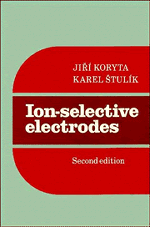Book contents
- Frontmatter
- Contents
- Preface
- 1 Introduction
- 2 The theory of membrane potentials
- 3 The theory of membrane potentials in ion-selective electrodes
- 4 Principal properties of ion-selective electrodes
- 5 Experimental techniques
- 6 Ion-selective electrodes with solid or glassy membranes
- 7 Ion-selective electrodes with liquid membranes
- 8 Potentiometric biosensors
- 9 Voltammetry at the interface of two immiscible electrolyte solutions
- Appendix
- Index
4 - Principal properties of ion-selective electrodes
Published online by Cambridge University Press: 05 November 2011
- Frontmatter
- Contents
- Preface
- 1 Introduction
- 2 The theory of membrane potentials
- 3 The theory of membrane potentials in ion-selective electrodes
- 4 Principal properties of ion-selective electrodes
- 5 Experimental techniques
- 6 Ion-selective electrodes with solid or glassy membranes
- 7 Ion-selective electrodes with liquid membranes
- 8 Potentiometric biosensors
- 9 Voltammetry at the interface of two immiscible electrolyte solutions
- Appendix
- Index
Summary
As stated on p. 28, an analytically ideal sensor would determine the determinand both specifically and quantitatively. In potentiometry, this would require an electrode sensitive to one single substance among all the components of the system.
Cationic metal electrodes definitely do not have this property. They attain (though not always) a potential that is a function of the activity of the corresponding ion according to the Nernst equation; however, in the presence of the ions of nobler metals these electrodes become covered with a layer of the deposited nobler metal and thus have quite different properties. Again, in the presence of components of oxidation-reduction systems in the test solution, mixed potentials develop at these electrodes (see for example [86a], and p. 000). The dependence of this potential on the solution composition is complex and thus such electrodes are unsuitable for analytical purposes. Some cation electrodes do not obey the Nernst equation with respect to the corresponding ions and their potentials are simultaneously affected by the formation of an oxide film and by reactions with various solution components (hydrogen ions, oxygen, etc.). Therefore, cation electrodes are not suitable sensors for specific estimation of the determinand concentration. In optimal cases, redox electrodes sometimes yield thermodynamic potentials corresponding to components in the solution, but mixed potentials are also often encountered.
Anion electrodes of the second kind have better properties in this respect. They respond to the corresponding anions over wide activity ranges and the only major interference with their function comes from anions forming salts less soluble than the salt covering the electrode.
- Type
- Chapter
- Information
- Ion-Selective Electrodes , pp. 56 - 88Publisher: Cambridge University PressPrint publication year: 1983



